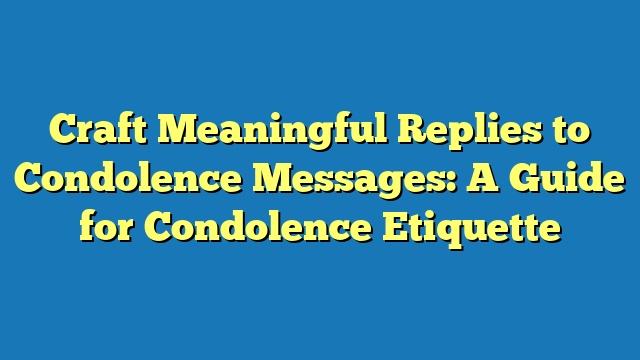A “reply for the condolence message” is a response to a message offering condolences, typically expressed after the loss of a loved one.
These replies hold great importance as they provide an avenue for the bereaved to express their gratitude for the sympathy and support extended during their time of grief. They acknowledge the kindness of others and strengthen the bonds of community during challenging times. Historically, the practice of sending condolence messages and replies originated in ancient cultures as a way to show empathy and solidarity with those who had suffered a loss.
In the following section, we will delve into the etiquette, structure, and thoughtful expressions commonly found in replies for condolence messages.
Reply for the Condolence Message
Replies to condolence messages serve as heartfelt and meaningful responses to expressions of sympathy during times of grief. These key aspects underscore their significance:
- Grateful Acknowledgment
- Emotional Validation
- Preservation of Memory
- Expression of Appreciation
- Conveyance of Support
- Strengthened Bonds
- Cultural Significance
- Historical Importance
These aspects are interconnected, forming a framework for respectful and compassionate communication. They allow the bereaved to express their gratitude for the support, acknowledge the emotions evoked by the loss, preserve the memory of the departed, and convey their appreciation for the thoughtfulness of others. Replies for condolence messages not only strengthen the bonds within a community but also hold cultural and historical significance, reflecting the importance of empathy and solidarity during moments of adversity.
Grateful Acknowledgment
In the realm of condolence messages, grateful acknowledgment forms the cornerstone of appropriate and meaningful replies. It is the heartfelt expression of gratitude for the sympathy and support extended during a time of profound loss.
-
Recognition of Empathy
Replies often begin by acknowledging the sender’s understanding and empathetic words, which provide solace and comfort during a difficult time.
-
Appreciation for Thoughtfulness
The bereaved express appreciation for the thoughtful gestures, such as attending the funeral or sending flowers, which demonstrate genuine care and concern.
-
Validation of Emotions
Condolence replies validate the emotions experienced by the bereaved, recognizing the pain, sadness, and sense of loss they are grappling with.
-
Strengthened Bonds
The act of sending and receiving condolence messages strengthens the bonds within a community, reminding the bereaved that they are not alone in their grief.
Grateful acknowledgment in condolence replies weaves together empathy, appreciation, validation, and community support, creating a tapestry of compassion that helps the bereaved navigate their journey through grief.
Emotional Validation
Emotional validation is a crucial aspect of replies to condolence messages, as it provides recognition and support for the bereaved’s feelings during a difficult time.
-
Empathetic Understanding
Replies often express empathetic understanding of the bereaved’s emotions, acknowledging their pain, sadness, and sense of loss.
-
Normalization of Emotions
Replies can help normalize the bereaved’s emotions, reminding them that their feelings are natural and shared by others.
-
Respect for Individuality
Replies respect the individuality of the bereaved’s grief, recognizing that each person experiences loss differently.
-
Avoidance of Clichs
Replies avoid using dismissive or clichd phrases that may invalidate the bereaved’s emotions.
Emotional validation in replies for condolence messages provides a supportive and compassionate environment for the bereaved, allowing them to feel understood and supported during their time of grief.
Preservation of Memory
Preservation of memory plays a crucial role in replies to condolence messages, as it keeps the memory of the deceased alive and honors their legacy.
When mourners share stories, anecdotes, or special moments about the departed, they are not only expressing their grief but also preserving the memory of their loved one. These shared memories create a tapestry of the person’s life, ensuring that their spirit lives on.
Replies to condolence messages provide a platform for the bereaved to share their memories and express their gratitude for the life of the deceased. By doing so, they not only comfort themselves but also contribute to the collective memory of their loved one, ensuring that they are remembered and cherished for generations to come.
Expression of Appreciation
In the realm of condolence messages, the expression of appreciation holds a significant place. When a bereaved individual receives a message of sympathy and support, they often feel compelled to respond with gratitude. This expression of appreciation is not merely a social convention but a heartfelt acknowledgment of the kindness and compassion extended during a difficult time.
The expression of appreciation in a reply for a condolence message serves multiple purposes. First and foremost, it conveys the bereaved’s genuine thanks to those who have reached out to them. This acknowledgment lets the sender know that their words have been received and appreciated, providing a sense of comfort and connection. Moreover, expressing appreciation strengthens the bonds between the bereaved and their community, fostering a sense of shared support and understanding.
Real-life examples of expressions of appreciation in reply for condolence messages abound. Bereaved individuals often use phrases such as “Thank you for your kind words,” “Your message brought me solace during this difficult time,” or “I am deeply touched by your thoughtfulness.” These expressions, though simple, convey a profound sense of gratitude and appreciation.
The practical significance of understanding the connection between expression of appreciation and reply for the condolence message lies in its ability to guide individuals in offering support to the bereaved. By acknowledging the importance of expressing gratitude, individuals can ensure that their messages of sympathy are received with the same warmth and appreciation they intended.
Conveyance of Support
In the heartfelt realm of replies to condolence messages, the conveyance of support emerges as a cornerstone of compassionate communication. It encompasses a range of expressions and gestures aimed at providing comfort, solace, and strength to those grieving the loss of a loved one.
-
Emotional Support
Replies often convey emotional support by acknowledging the bereaved’s pain, validating their feelings, and offering words of empathy and understanding.
-
Practical Support
Practical support can be conveyed through offers of assistance with daily tasks, such as running errands, preparing meals, or providing childcare. These gestures demonstrate a willingness to alleviate the burdens faced by the bereaved.
-
Spiritual Support
For those seeking spiritual solace, replies may offer words of comfort and guidance drawn from religious or spiritual traditions. This support can provide a sense of peace and connection during a difficult time.
-
Social Support
Replies can convey social support by expressing the sender’s presence and availability to listen, talk, or simply the bereaved. This sense ofship can help alleviate feelings of isolation and loneliness.
The conveyance of support in replies to condolence messages serves as a powerful reminder that the bereaved are not alone in their grief. These expressions of compassion and care provide a lifeline of strength and support, helping them navigate the challenging journey through loss.
Strengthened Bonds
In the realm of replies to condolence messages, the concept of strengthened bonds emerges as a central theme, intricately connected to the very essence of these heartfelt communications.
Replies to condolence messages serve as a catalyst for strengthening bonds between individuals, families, and communities during times of grief. By expressing sympathy, offering support, and acknowledging the pain of loss, these messages foster a sense of unity and collective understanding. The act of sending and receiving condolence messages creates a shared experience, drawing people closer together and reinforcing the strength of their connections.
Real-life examples of strengthened bonds through replies to condolence messages abound. When a bereaved individual receives a thoughtful message of sympathy, they often feel a sense of comfort and connection. This connection can extend beyond the immediate family, reaching out to friends, colleagues, and even acquaintances who offer their support. The exchange of condolences allows individuals to express their emotions, share memories of the deceased, and provide solace to one another, thereby strengthening the bonds that unite them.
The practical significance of understanding the connection between strengthened bonds and replies to condolence messages lies in its ability to guide individuals in offering support to the bereaved. By recognizing the importance of strengthening bonds, individuals can ensure that their messages of sympathy are not only heartfelt but also contribute to the healing process of those who are grieving.
Cultural Significance
Cultural significance permeates the realm of condolence message replies, reflecting the deeply rooted customs, traditions, and beliefs embedded within these heartfelt communications. These replies transcend mere expressions of sympathy, becoming vessels that carry cultural values and shape societal norms surrounding grief and loss.
-
Intercultural Variations
Condolence message replies vary significantly across cultures, reflecting diverse customs and traditions. In some cultures, elaborate rituals and ceremonies accompany these messages, while in others, a simple yet heartfelt note suffices.
-
Expression of Values
Replies to condolence messages often embody cultural values and beliefs. In collectivist cultures, messages may emphasize the importance of family and community support, while in individualistic cultures, they may focus on personal strength and resilience.
-
Historical Evolution
Cultural significance in condolence message replies has evolved over time, shaped by historical events and societal changes. In the past, these messages were often delivered in person or through written letters, while today, they are commonly conveyed through electronic means.
-
Social Impact
Condolence message replies have a profound social impact, reinforcing bonds within communities and providing a sense of collective support. They create a shared space where individuals can express their grief and find solace in knowing that they are not alone.
Understanding the cultural significance of replies to condolence messages is essential for navigating these communications with sensitivity and respect. By recognizing the diverse customs, values, and traditions associated with these messages, we can ensure that our expressions of sympathy are meaningful and culturally appropriate.
Historical Importance
The historical importance of replies to condolence messages lies in their ability to provide a glimpse into the cultural and societal norms surrounding grief and loss. By examining these messages across different time periods and cultures, we gain insights into how societies have grappled with the complexities of death and bereavement.
Real-life examples of the historical importance of condolence message replies abound. The ancient Egyptians, for instance, placed great emphasis on elaborate mourning rituals, and their condolence messages often reflected this cultural preoccupation. In Victorian England, condolence letters were an essential part of mourning etiquette, and their content and style were governed by strict social conventions. These historical examples demonstrate how replies to condolence messages have shaped and been shaped by the cultural and societal contexts in which they are written.
Understanding the historical importance of replies to condolence messages has practical applications in several areas. For historians, these messages provide valuable insights into the past, helping them to reconstruct cultural practices and social norms. For sociologists, they offer a window into the evolution of grief and bereavement practices. And for individuals seeking to offer support to those who are grieving, an understanding of the historical context of condolence messages can help them to craft meaningful and culturally sensitive responses.
In conclusion, the historical importance of replies to condolence messages lies in their ability to provide insights into cultural norms, societal values, and the evolution of grief and bereavement practices. By examining these messages across different time periods and cultures, we gain a deeper understanding of the human experience of loss and the ways in which societies have responded to it.
Frequently Asked Questions about Replies for Condolence Messages
This section addresses commonly asked questions regarding replies to condolence messages, providing clear and concise answers to guide individuals in crafting meaningful and appropriate responses during times of grief.
Question 1: What is the purpose of a reply to a condolence message?
Answer: A reply to a condolence message serves to acknowledge the expression of sympathy, convey gratitude for the support, and provide emotional validation to the sender. It is a way of showing that their words have been received and appreciated.
Question 2: What should be included in a reply to a condolence message?
Answer: A thoughtful reply typically includes an expression of gratitude, acknowledgment of the sender’s kind words, and a brief personal touch, such as sharing a memory of the deceased or expressing appreciation for their support.
Question 3: How should I respond to a condolence message if I am not close to the sender?
Answer: Even if you are not close to the sender, it is important to acknowledge their message with a brief and sincere reply. Express your condolences and let them know that their support is appreciated.
Question 4: Is it appropriate to send a reply to a condolence message if I did not know the deceased?
Answer: Yes, it is perfectly acceptable to send a reply to a condolence message even if you did not know the deceased. Your message can express sympathy for the sender’s loss and offer support during their time of grief.
Question 5: How long should a reply to a condolence message be?
Answer: The length of a reply to a condolence message can vary, but it should be long enough to convey your sincerity and support without being overly lengthy. A few sentences or a short paragraph is generally sufficient.
Question 6: What should I do if I am struggling to find the right words to reply to a condolence message?
Answer: If you are struggling to find the right words, consider using a simple and heartfelt message. Expressing your sympathy and letting the sender know that you are thinking of them can be more meaningful than trying to craft an elaborate response.
These FAQs provide a framework for understanding the purpose, content, and etiquette of replies to condolence messages. By thoughtfully considering these aspects, individuals can craft meaningful and appropriate responses that offer comfort and support to those who are grieving.
The next section will delve deeper into the cultural and historical significance of replies to condolence messages, exploring their role in different societies and time periods.
Tips for Crafting Meaningful Replies to Condolence Messages
When responding to a condolence message, it is important to convey your sincerity and support while respecting the grieving process of the sender. Here are a few tips to help you craft meaningful and appropriate replies:
Tip 1: Respond promptly
A timely response shows that you care and are there for the sender during their time of need.
Tip 2: Personalize your message
Include a personal touch, such as a shared memory of the deceased or a specific way in which you will miss them.
Tip 3: Avoid clichs
Instead of using generic phrases, express your sympathy in a unique and heartfelt way.
Tip 4: Offer specific support
Let the sender know that you are there for them, whether it’s to listen, run errands, or provide a shoulder to cry on.
Tip 5: Respect the sender’s boundaries
Understand that everyone grieves differently. Respect the sender’s need for space or time.
Tip 6: Follow up
Check in with the sender after some time has passed to let them know that you’re still thinking of them.
Tip 7: Be mindful of your words
Choose your words carefully and avoid saying anything that could be hurtful or dismissive.
Tip 8: Proofread your message
Before sending your reply, proofread it to ensure that it is clear, concise, and free of errors.
These tips will help you craft meaningful and supportive replies to condolence messages, providing comfort and support to those who are grieving.
The next section will explore the cultural and historical significance of replies to condolence messages, shedding light on their role in different societies and time periods.
Conclusion
In exploring the multifaceted nature of replies to condolence messages, this article has shed light on their profound cultural significance, historical evolution, and practical applications. We have delved into the ways in which these messages strengthen bonds, provide emotional support, and contribute to the grieving process.
Three key points emerge from our exploration:
- Replies to condolence messages serve as a vital means of acknowledging and validating the emotions of those who are grieving.
- These messages reflect and shape cultural norms surrounding grief and loss, providing insights into societal values and beliefs.
- Crafting meaningful replies requires sensitivity, empathy, and a willingness to offer genuine support to those who are grieving.
As we navigate the complexities of human loss, let us remember the significance of replies to condolence messages. May we strive to offer words that provide solace, comfort, and a sense of shared humanity during times of profound sorrow.









Tips for Using "Template by Kevin Crafts" Comments for Meaningful Online Discussions